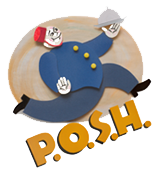Antique Silverplate & Crystal Claret Jug
Antique Silverplate & Crystal Claret Jug
$375.00
The Victorian era, named after England's Queen Victoria, lasted from the 1830's to the turn of the 20th century and was an era of abundance and beauty. An example of this abundance can be found by looking no further than a proper Victorian table setting with its myriad of distinct serving pieces. Indeed every item of food or drink had its distinct utensil or means of presentation.
Case in point: this regal Antique Silverplate and Cut Crystal Claret Jug, designed for decanting and serving red wine (particularly red Bordeaux wines) with the elegance and sophistication that the Victorian era demanded. Its beautifully opulent cut crystal showcases the fine craftsmanship demanded in articulating multiple patterns within a single piece. A mixture of starburst and diamond glass cuts around the perimeter bring to mind the romantic shape of gothic windows. Sweetly showcased within these panels, a more delicate, botanic floral and fern motif seems to dance in the light.
Produced by talented Sheffield silversmiths Martin Hall & Co., a range of decorative patterns have also been expertly executed on the silverplate neck, lid and handle, including a lovely dimensional finial. With a grand presence befitting a special vintage or favorite beverage, this magnificent jug with its silverplated lid and handle is sure to become a prized addition to your table and barware collection.
One-of-a-kind and subject to prior sale. 9.5"H x 5.5" in diameter. In good antique condition.
Learn More About Claret Jugs
For most of the 18th century, wines were either served out of solid silver pitchers, or from glass decanters and bottles. Most wealthy households purchased wines in casks which were stored in the cellar, from which the head butler would decant into the appropriate serving vessel prior to the meal.
It was not until the early 19th century when glass manufacturing developed sufficiently that wines were bottled at the source in uniform bottles. This probably explains the sudden appearance of silver mounted claret jugs from about 1830 onwards. As the use and storage of wine became easier, and as the industrial revolution produced a larger consumer class yearning for finer living and drinking, so the demand and consumption of wine grew and with it the need for new conventions, customs and accessories.
To that end, the claret jug was introduced throughout Europe in the early 19th century when silversmiths embellished glass decanters with silver mounts, lids and handles.
The design and style of claret jugs evolved over time, driven by the ever-changing whims of fashion. From highly ornate to whimsically designed jugs in the shapes of animals, claret jugs reflected the desires of a society to display their new-found wealth and taste for the finer things of life.
Learn More About Claret
Before “claret” was the nickname for Bordeaux wines, it meant “clear,” “pale” or “light-colored” wine (“claret” being derived from the Latin word for “clear”). This is back in the 14th and 15th centuries, when wines from Bordeaux were actually paler, almost like rosés. In the late Middle Ages, “claret” also referred to a heated wine poured over a bag of spices.
The first known references to “claret” as dark red Bordeaux wines were in the 1700s by the British trade. History buffs will recall that France and England were at war during this period, and it was right around then that the English started seeking out Portuguese wines to satisfy their thirst.
These days “claret” is used as a generic way to refer to Bordeaux wines - or wines styled after Bordeaux.


























